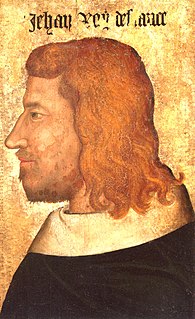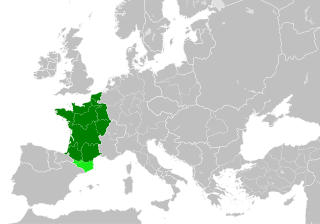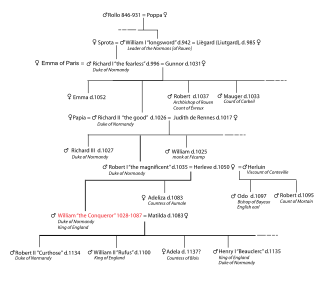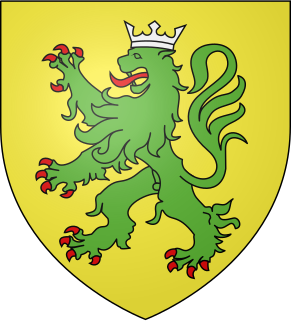Related Research Articles
William I, usually known as William the Conqueror and sometimes William the Bastard, was the first Norman King of England, reigning from 1066 until his death in 1087. He was a descendant of Rollo and was Duke of Normandy from 1035 onward. His hold was secure on Normandy by 1060, following a long struggle to establish his throne, and he launched the Norman conquest of England six years later. The rest of his life was marked by struggles to consolidate his hold over England and his continental lands, and by difficulties with his eldest son, Robert Curthose.

Edward III, also known as Edward of Windsor before his accession, was King of England and Lord of Ireland from January 1327 until his death. He is noted for his military success and for restoring royal authority after the disastrous and unorthodox reign of his father, Edward II. Edward III transformed the Kingdom of England into one of the most formidable military powers in Europe. His fifty-year reign was the second-longest in medieval English history, and saw vital developments in legislation and government, in particular the evolution of the English Parliament, as well as the ravages of the Black Death. He outlived his eldest son, Edward the Black Prince, and the throne passed to his grandson, Richard II.

Philip VI, called the Fortunate and of Valois, was the first King of France from the House of Valois. He reigned from 1328 until his death.

John II, called John the Good, was King of France from 1350 until his death.

Caen is a commune in northwestern France. It is the prefecture of the department of Calvados. The city proper has 108,365 inhabitants, while its urban area has 420,000, making Caen the largest city in former Lower Normandy. It is also the third largest municipality in all of Normandy after Le Havre and Rouen and the third largest city proper in Normandy, also after Rouen and Le Havre. The metropolitan area of Caen, in turn, is the second largest in Normandy after that of Rouen, the 21st largest in France.

Lower Normandy is a former administrative region of France. On 1 January 2016, Lower and Upper Normandy merged becoming one region called Normandy.

The Kingdom of France in the Middle Ages was marked by the fragmentation of the Carolingian Empire and West Francia (843–987); the expansion of royal control by the House of Capet (987–1328), including their struggles with the virtually independent principalities that had developed following the Viking invasions and through the piecemeal dismantling of the Carolingian Empire and the creation and extension of administrative/state control in the 13th century; and the rise of the House of Valois (1328–1589), including the protracted dynastic crisis of the Hundred Years' War with the Kingdom of England (1337–1453) compounded by the catastrophic Black Death epidemic (1348), which laid the seeds for a more centralized and expanded state in the early modern period and the creation of a sense of French identity.

The Duchy of Normandy grew out of the 911 Treaty of Saint-Clair-sur-Epte between King Charles III of West Francia and the Viking leader Rollo. The duchy was named for its inhabitants, the Normans.

In the Middle Ages, the Duke of Normandy was the ruler of the Duchy of Normandy in north-western France. The duchy arose out of a grant of land to the Viking leader Rollo by the French king Charles III in 911. In 924 and again in 933, Normandy was expanded by royal grant. Rollo's male-line descendants continued to rule it down to 1135. In 1202 the French king Philip II declared Normandy a forfeited fief and by 1204 his army had conquered it. It remained a French royal province thereafter, still called the Duchy of Normandy, but only occasionally granted to a duke of the royal house as an apanage.

Odo IV or Eudes IV was Duke of Burgundy from 1315 until his death and Count of Burgundy and Artois between 1330 and 1347. He was the second son of Duke Robert II and Agnes of France.

Norman or Norman French is, depending on classification, either a French dialect or a Romance language which can be classified as one of the Oïl languages along with French, Picard and Walloon. The name "Norman French" is sometimes used to describe not only the Norman language, but also the administrative languages of Anglo-Norman and Law French used in England. For the most part, the written forms of Norman and modern French are mutually intelligible. This intelligibility was largely caused by the Norman language's planned adaptation to French orthography.
The precise style of British sovereigns has varied over the years. The present style is officially proclaimed in two languages:

The Angevin Empire describes the possessions of the Angevin kings of England who held lands in England and France during the 12th and 13th centuries. Its rulers were Henry II, Richard I (r. 1189–1199), and John (r. 1199–1216). The Angevin Empire is an early example of a composite state.

The Siege of Calais occurred at the conclusion of the Crécy campaign, when an English army under the command of King Edward III of England successfully besieged the French town of Calais during the Edwardian phase of the Hundred Years' War.

The Battle of Caen on 26 July 1346 was the assault on the French-held town by elements of an invading English army under King Edward III as a part of the Hundred Years' War. The English army numbered 12,000–15,000, and part of it, nominally commanded by the Earls of Warwick and Northampton, prematurely attacked the town. Caen was garrisoned by 1,000–1,500 soldiers and an unknown, but large, number of armed townsmen, commanded by Raoul, the Count of Eu, the Grand Constable of France. The town was captured in the first assault; more than 5,000 of the ordinary soldiers and townspeople were killed and a few nobles were taken prisoner. The town was then sacked for five days.
Anglo-Norman, also known as Anglo-Norman French, was a dialect of Old Norman French that was used in England and, to a lesser extent, elsewhere in Great Britain and Ireland during the Anglo-Norman period.

The Hundred Years' War was a series of conflicts in Western Europe from 1337 to 1453, waged between the House of Plantagenet and its cadet House of Lancaster, rulers of the Kingdom of England, and the House of Valois over the right to rule the Kingdom of France. It was one of the most notable conflicts of the Middle Ages, in which five generations of kings from two rival dynasties fought for the throne of the largest kingdom in Western Europe. The war marked both the height of chivalry and its subsequent decline, and the development of stronger national identities in both countries.

The Crécy campaign was a large-scale raid (chevauchée) conducted by an English army throughout northern France in 1346, which devastated the French countryside on a wide front and culminated in the eponymous Battle of Crécy. It was part of the Hundred Years' War. The campaign began on 12 July 1346, with the landing of English troops in Normandy, and ended with the capitulation of Calais on 3 August 1347. The English army was led by King Edward III, and the French by King Philip VI.

Robert VIII Bertrand de Bricquebec, also known as Robert Bertrand, Baron of Bricquebec, Viscount of Roncheville, was a 14th century Norman noble. He served as Marshal of France from 1325 until 1344.

Geoffroy de Harcourt, "the lame" Viscount of Saint-Sauveur, was a 14th century French noble.
References
- ↑ John Aberth, From the Brink of Apocalypse. Confronting Famine, War, Plague, and Death in the Later Middle Ages (Routledge, 2001), p. 74.
- ↑ Anne Curry, The Hundred Years' War (Palgrave, 2003), p. 7.
- ↑ Travers Twiss, ed. (1871). The Black Book of the Admiralty, with an Appendix. 1. London: Longman & Co., and Trübner & Co. p. 420. Retrieved 2019-06-20.
- "lange". Anglo-Norman Dictionary. 2008–2012. Retrieved 2019-06-20.
- "langue". Dictionnaire du Moyen Français (1330-1500). 2015. Retrieved 2019-06-20.
- ↑ Kibbee, Douglas (1991). For to Speke Frenche Trewely: The French Language in England, 1000-1600: Its Status, Description and Instruction. John Benjamins Publishing. p. 34. ISBN 9789027245472.
- ↑ Deanne Williams, The French Fetish from Chaucer to Shakespeare (Cambridge University Press, 2007), p. 18.